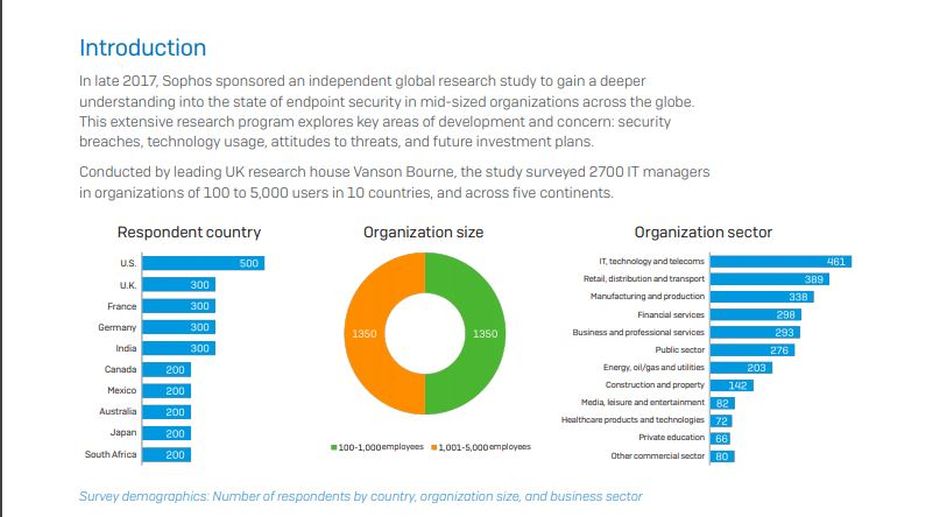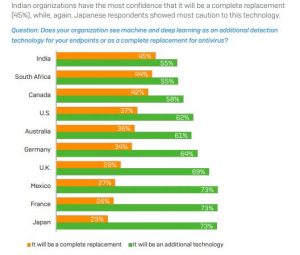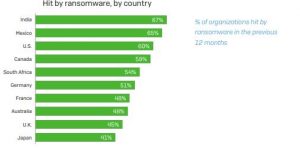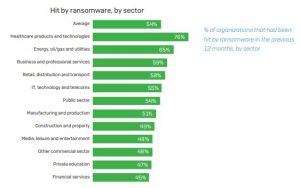96 pc ransomware affected Indian firms engaged with law enforcement for help: Report
According to the cybersecurity firm Sophos, about 59 per cent of the organisations that did engage with law enforcement also reported finding the process easy.
Survey by security software and hardware company Sofos shows the extent to which Indian businesses are at a risk of repeated ransomware attacks

Survey by Sofos shows the extent to which Indian businesses are at a risk of repeated ransomware attacks
In India, 67 per cent businesses were hit by ransomware last year. And at 53.77 per cent, the number of devices infected per organisation is higher than the global average (46.09 per cent). Also, while $13.74 mn was spent by 3 per cent of the organisations worldwide to rectify the impact of ransomware, India’s share was highest at a mean cost of $1.17mn.
The figures came to the fore after Sophos, a global security software and hardware company, announced the India findings of its survey, The State of Endpoint Security Today. The survey shows the extent to which Indian businesses are at a risk of repeated ransomware attacks.
Advertisement
More than 2,700 IT decision-makers across mid-sized businesses were polled in 10 countries for the survey. These countries were US, Canada, Mexico, France, Germany, UK, Australia, Japan, South Africa and India. The survey concludes that despite the intensity and magnitude of attacks, Indian businesses are still not prepared to defend itself against determined attackers.
Advertisement
Ransomware continues to be a major issue across the globe with 54 per cent of the organisations surveyed hit in the last year and a further 31 per cent expecting to be victims of an attack in the future. On average, respondents impacted by ransomware were struck twice.

“Unlike lightening, ransomware can strike again and again to the same organisation. We’re aware of cybercriminals unleashing four different ransomware families in half-hour increments to ensure at least one evades security and completes the attack,” said Sunil Sharma, Managing Director, Sales, at Sophos India & SAARC.
“Today’s persistent cybercriminals are deploying multiple attack methods to succeed, whether using a mix of ransomware in a single campaign, taking advantage of a remote access opportunity, infecting a server, or disabling security software. If IT managers are unable to thoroughly clean ransomware and other threats from their systems after attacks, they could be vulnerable to reinfection. No one can afford to be complacent,” he added.

According to Sophos, this relentless attack methodology “combined with the growth in Ransomware-as-a-Service”, the anticipation of more complex threats, and the resurgence of worms like WannaCry and NotPetya puts businesses in serious need of a security makeover. In fact, more than 90 per cent of the Indian IT decision makers surveyed and impacted by ransomware were running up-to-date endpoint protection, confirming that traditional endpoint security was no longer enough to protect against ransomware attacks.
According to those impacted last year worldwide, the median total cost of an attack was $133,000 — in rectifying the impacts. In India, the corresponding figure was $1.17mn, the highest. This extends beyond any ransom demanded and includes downtime, manpower, device cost, network cost, and lost opportunities.

Unfortunately, the survey revealed considerable misunderstanding around technologies to stop exploits, with 72 per cent of the IT professionals surveyed unable to correctly identify the definition of anti-exploit software. With this confusion, it’s not surprising that 45 per cent do not have anti-exploit technology in place at all. This also suggests that a significant proportion of organisations have a misplaced belief that they are protected from this common attack technique yet are actually at significant risk, says the report.
Intrusions from exploits also have been happening for years but are still a prominent threat and often go undetected for months, if not years. Once inside a system, cybercriminals use complex malware that can hide in memory or camouflage itself. In many cases, businesses do not know they have been breached until someone finds a large cache of stolen data on the Dark Web, finds the survey.
Though 94 per cent of the respondents admitted their endpoint defenses needed to be stronger to block the attacks seen last year, only 34 per cent had predictive threat technologies, such as machine or deep learning, leaving 66 per cent vulnerable to repeated ransomware attacks, exploits, and evolving advanced threats.
“Given the speed at which IT threats are evolving and becoming more persistent and coordinated, it is a deep concern to see the adoption of the next-generation predictive technologies. It is important for organisations to keep up in this dynamic world of IT threats. Organizations need effective anti-ransomware, anti-exploit, and deep learning technology to stay secure in 2018 and beyond,” said Sharma.
The State of Endpoint Security Today survey was conducted by Vanson Bourne, an independent specialist in market research. This survey interviewed 2,700 IT decision makers, of which 300 respondents were from India, based in Delhi, Mumbai, Hyderabad, Bangalore, Kolkata and Chennai. These employees were from varied sectors such as financial services, IT, technology and telecoms, business and professional services, manufacturing and production amongst others.
Key findings on India
91% Indian organisations claimed to running up-to-date endpoint protection when impacted by ransomware
$13.74 mn spent by 3% of the organisations worldwide to rectify the impact of ransomware. India’s share highest at $1.17mn
53.77% devices infected per organisation — higher than the global average infections at 46.09%
76 % companies impacted were in the healthcare sector — the highest
Over 70 % surveyed do not have anti-exploit technology, which means these businesses are easy prey for data breaches and complex threats like WannaCry
Over 70% IT professionals surveyed were unable to identify the correct definition of anti-exploit technology
89% India respondents said malware threats had got more complex over the last year
99% businesses optimistic about deploying machine learning technology
Advertisement